Training your beloved dog to become a service dog is a rewarding and challenging process. Not only will your furry friend assist individuals with disabilities, but it will also strengthen the bond between you and your canine companion. While the training process can seem daunting, it’s essential to keep in mind that it’s a gradual and consistent process. In this section, we’ll provide a step-by-step guide on how to train your dog as a service dog, including helpful tips and best practices for professional service dog training.
- Training your dog to become a service dog is a gradual and consistent process.
- Understanding the role of a service dog and selecting the right dog for service work is crucial.
- Establishing basic obedience training and introducing public etiquette and socialization are vital aspects of service dog training.
- Different disabilities require different tasks from service dogs, and handling distractions and challenges is part of the training process.
- Continuing training, maintaining the health and wellness of the dog, building a strong bond and trust, and finalizing the service dog training process are essential steps.
Understanding the Role of a Service Dog
Before diving into the training process, it’s crucial to understand the role of a service dog. Service dogs are specially trained animals that assist individuals with disabilities in performing daily tasks, navigating public spaces, and providing emotional support. These dogs are not pets, but rather, they are a vital tool that enables individuals with disabilities to achieve greater independence and quality of life.
Service dogs are trained to perform specific tasks that are tailored to the individual’s disability. This can include tasks such as guiding the visually impaired, alerting the deaf, assisting with mobility, detecting seizures, and providing emotional support.
Service dogs must be well-behaved, obedient, and reliable in public settings. They need to remain calm and focused in crowds, noisy environments, and other distracting situations. Additionally, they need to have excellent public etiquette and socialization skills to avoid causing any disruptions or disturbances.
When training a service dog, it’s essential to adhere to best practices and effective techniques that will enable the dog to perform its duties safely and reliably. This can include positive reinforcement techniques, reward-based training, and consistent training routines.
| Best Practices for Training a Service Dog | Service Dog Training Techniques |
|---|---|
| Start training as early as possible | Positive reinforcement training |
| Be consistent and patient with training | Task analysis and shaping |
| Expose your dog to various environments and distractions | Chaining and shaping behaviors |
| Use high-value rewards to reinforce positive behaviors | Behavioral obedience training |
| Stay attuned to your dog’s needs and limitations | Multi-sensory training |
Understanding the role of a service dog is the first step towards successful training. By following best practices and effective training techniques, you can equip your dog with the skills necessary to perform its duties safely and reliably, leading to a happy and fulfilling life for both the dog and its owner.
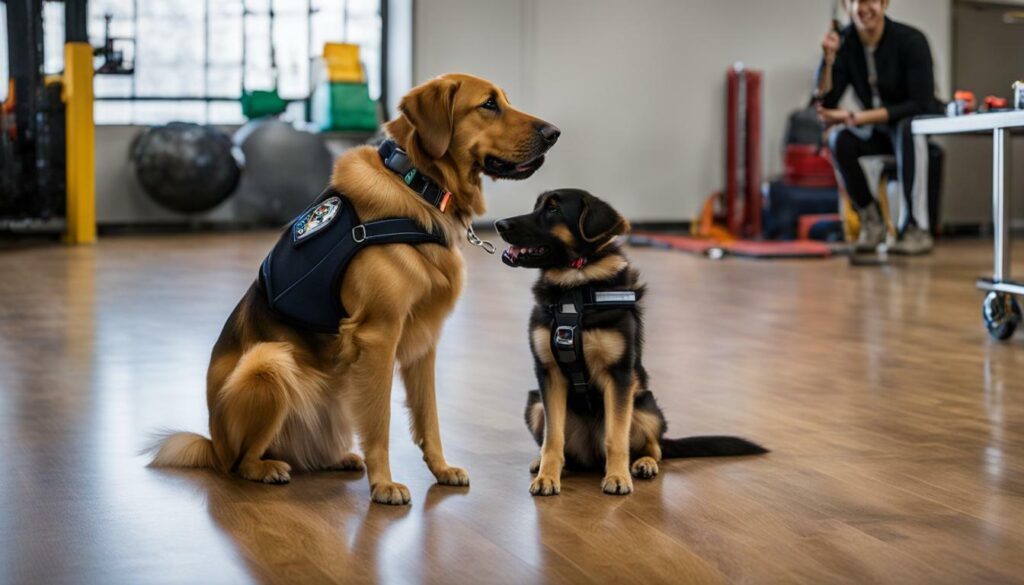
Choosing the right dog is the first and most crucial step in training a service dog. Service dogs come in different breeds, sizes, and temperaments. However, certain breeds such as Golden Retrievers, Labrador Retrievers, and German Shepherds are typically preferred due to their intelligence, trainability, and calm temperament.
When selecting a dog for service work, consider the size and weight of the dog in relation to the tasks they will perform. For example, a small dog may not be suitable for tasks that require pulling or bracing. Additionally, it’s essential to ensure that the temperament and personality of the dog are appropriate for the role of a service dog.
Training a service dog from puppyhood is a popular option since it provides a clean slate and allows you to shape the dog’s behavior from scratch. However, training a mature dog with the right temperament and aptitude for service work is also possible.
Service dog candidates must meet specific requirements such as being physically healthy, having the right temperament, and being well-behaved. Before beginning the training process, ensure that your dog meets these requirements and can pass a basic obedience test.
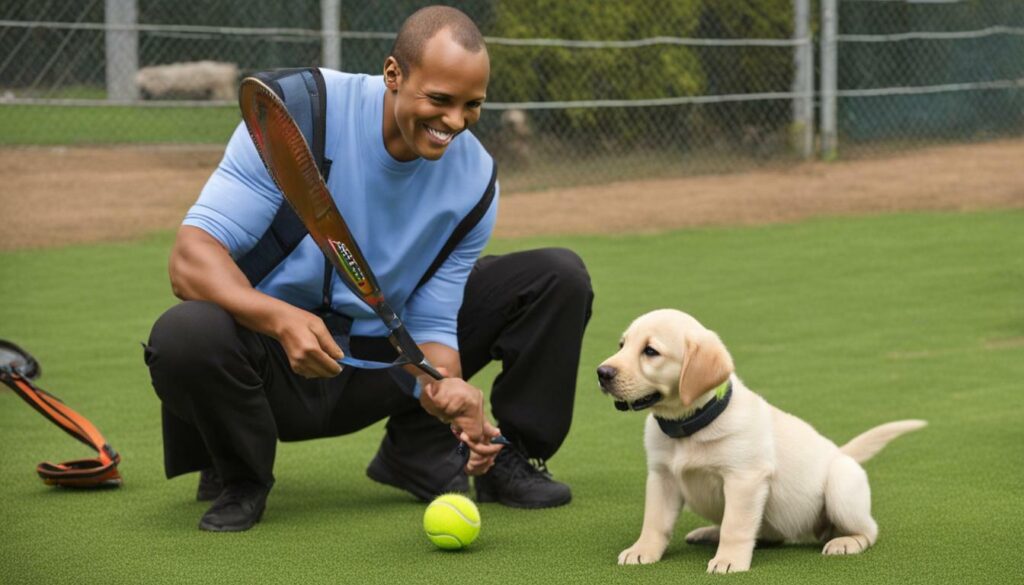
Training a service dog from an early age has several advantages. It allows you to shape the dog’s behavior, socialize them appropriately, and expose them to various experiences that will prepare them for their role as a service dog. Starting early also provides ample time to train, reinforce, and test their skills before they begin their service work.
Puppyhood training should focus on basic obedience, socialization, and exposure to different environments, stimuli, and distractions. Use positive reinforcement and reward-based training methods to encourage good behavior and discourage bad behavior.
Provide your puppy with lots of opportunities to socialize with other dogs and people. Take them to different places such as parks, stores, and restaurants to expose them to various environments and situations.
As the puppy grows, introduce specialized training for the tasks they will perform. Ensure that the dog is physically and mentally ready for the tasks, and progress gradually from simple to more complex tasks.
Overall, selecting the right dog is crucial for successful service dog training. Consider the breed, size, temperament, and requirements of the role when choosing a dog. Training from puppyhood can be advantageous, but it’s also possible to train mature dogs. Ensure that the dog meets the specific requirements and can pass a basic obedience test before beginning the training process.
Establishing Basic Obedience Training
Professional service dog training programs emphasize the importance of establishing a solid foundation of basic obedience training before initiating specialized tasks. Basic obedience training includes teaching your dog crucial commands such as sit, stay, come, and heel. These commands form the foundation for further advanced training and are vital in ensuring your dog’s safety and reliability in service.
There are various techniques and methods for teaching basic obedience training. Some popular methods include positive reinforcement using treats, clicker training, or verbal praise. As a professional dog trainer, you should choose a method that aligns best with your dog’s personality and learning style.
Consider joining a service dog training program if you’re uncertain about the proper approach to training your dog. These programs offer professional guidance and support to ensure your dog receives the best training possible.
During basic obedience training, your dog should learn to respond to commands both in and out of the home. Practice in various environments such as busy streets, quiet parks, and crowded indoor spaces to help your dog become comfortable and adaptable in diverse contexts.
Remember to remain consistent and patient during the training process. While dogs learn at different rates, with consistent training, they can learn and internalize commands. With proper training, your dog will have the skills and knowledge necessary to move onto more advanced training techniques.
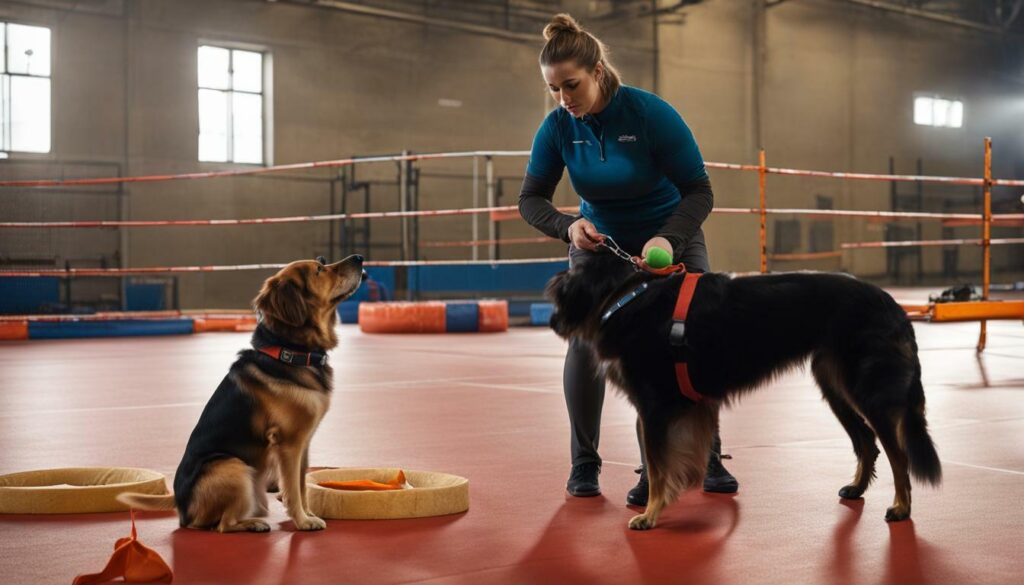
| Resource | Description |
|---|---|
| AKC Canine Good Citizen Program | A program that offers a ten-step test to evaluate and certify dogs for standard obedience training |
| American Humane Association’s Canine Behavior Series | A series of training videos and articles for training basic obedience and addressing common behavior problems in dogs |
| International Association of Assistance Dog Partners | An organization that promotes high-quality service dog training and provides resources for dog trainers and handlers |
Introducing Public Etiquette and Socialization
One of the core responsibilities of a service dog is to behave appropriately and calmly in public settings. Introducing your dog to various environments, people, and distractions is a critical part of their training to ensure they can handle real-life situations they may encounter while in service. Here are some service dog training tips to help you with public etiquette and socialization:
- Start slowly: Begin with familiar environments and gradually introduce new surroundings to your dog. It’s important to take time to build their confidence and avoid overwhelming situations.
- Positive reinforcement: Reward your dog for good behavior in public settings. Praise and treats can help reinforce positive associations with public environments and build their confidence.
- Controlled exposure: Expose your dog to different environments, people, and distractions in a controlled manner. Start with low-level distractions and gradually increase the level of difficulty as your dog becomes more comfortable.
- Practice obedience commands: Reinforce basic obedience training in public settings by practicing commands such as sit, stay, come, and heel. This helps your dog remain focused and calm in high stimulus environments.
Remember, socialization and public etiquette should be an ongoing part of your dog’s training. Regular exposure to different environments and people helps your dog build confidence and prepares them for their service work. It’s important to continue service dog training techniques to maintain your dog’s skills and ensure they remain well-behaved in public settings.
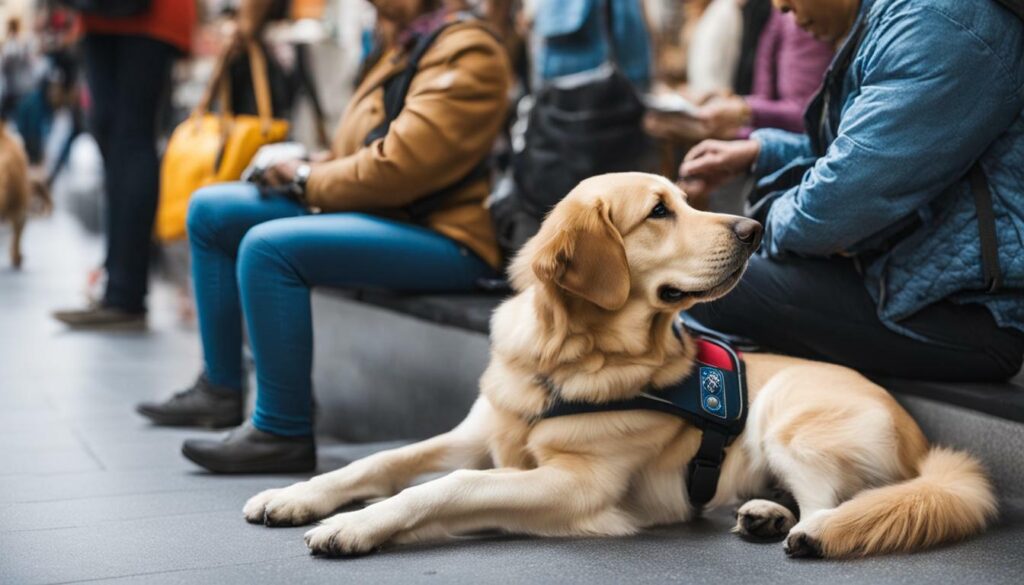
Service dogs perform a variety of tasks that cater to specific disabilities. Teaching your dog how to perform tasks can be challenging, but with the right approach and techniques, it can be achieved.
It’s essential to choose tasks that align with the specific needs of the person with a disability. For example, a service dog for a person with a hearing impairment should be trained to alert their owner to sounds, while a service dog for a person with diabetes should be trained to detect changes in blood sugar levels.
Here are some step-by-step instructions for teaching specific tasks:
- Retrieving objects: Start by teaching your dog to retrieve simple objects like toys and gradually work your way up to more complex items such as medicine bottles or phones. Use positive reinforcement techniques to motivate your dog to learn and progress.
- Opening doors: Begin by teaching your dog to push a lightweight door with their nose or paw. As your dog becomes more proficient, gradually increase the weight of the door.
- Providing medical alerts: For dogs trained to detect changes in blood sugar levels, introduce scent samples and gradually build up to real-life scenarios where your dog can alert you to changes in your blood sugar levels.
Service dog training techniques should be tailored to cater to specific tasks and disabilities. It’s essential to have patience and consistency during the training process to ensure your dog masters the tasks they need to perform.
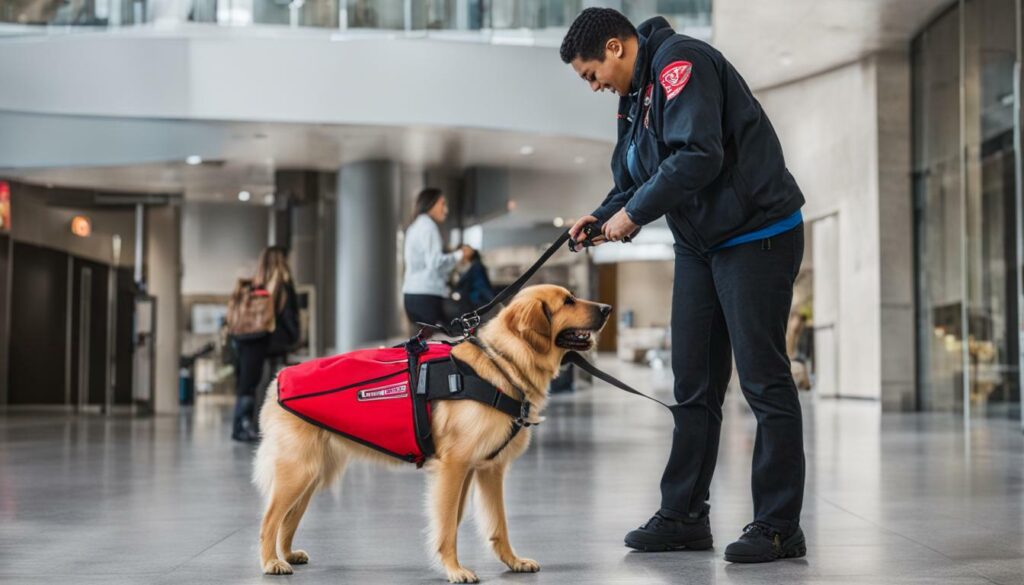
Service dogs encounter a wide range of distractions and challenges in their line of work. From crowded areas to unexpected loud noises, these factors can impact the dog’s ability to remain focused and calm. As a handler, it’s crucial to understand the techniques for handling these distractions and challenges effectively.
Here are some helpful service dog training tips to manage distractions and challenges:
- Start small by exposing your dog to minor distractions in a controlled setting, gradually increasing the intensity and duration of the distractions.
- Use verbal cues to redirect your dog’s attention back to the task at hand.
- Utilize positive reinforcement techniques, rewarding good behavior and ignoring unwanted behavior.
- Teach your dog to “leave it” or “ignore” certain distractions or stimuli.
- Keep training sessions short and frequent to avoid overstimulation and fatigue.
It’s also essential to prepare your service dog for stressful and unfamiliar environments such as airports, public transportation, and other crowded public places. Consistent exposure to different situations with gradual progress can help the dog become more confident and capable of handling any challenges they may face.
Service dog training programs often provide specialized training for handling distractions and challenges, ensuring that your dog is prepared for any situation they may encounter on the job. By investing in professional service dog training, you can equip your dog with the skills and confidence necessary to perform their task with efficiency and reliability.
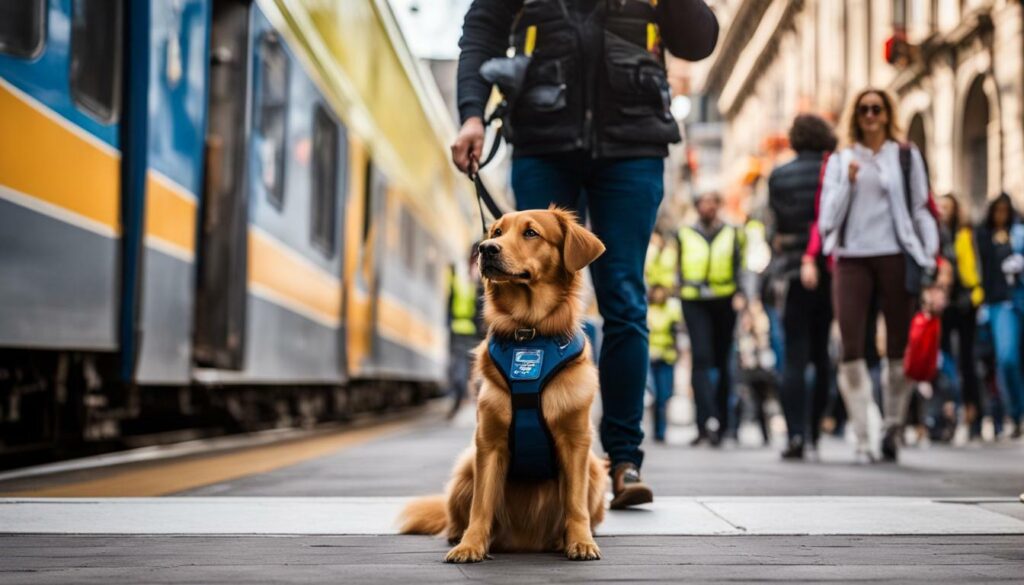
One crucial step towards completing the training process for a service dog is passing the Public Access Test. This test is designed to assess the dog’s behavior and skills in various public settings while performing specific tasks related to the handler’s disability. The test aims to ensure that the service dog is well-behaved, obedient, and capable of performing its duties in real-life situations.
Before taking the Public Access Test, make sure to familiarize yourself with the specific requirements and criteria. The test may vary depending on the location and governing body, but generally, it includes:
- Walking on a leash without pulling
- Sitting, staying, and lying down on command
- Remaining calm around people and other dogs
- Ignoring food and other distractions
- Performing specific tasks related to the handler’s disability
It’s essential to prepare your service dog for the Public Access Test adequately. Enroll in a professional service dog training program that offers specialized training for the test. These programs can help you reinforce essential skills and behaviors and introduce your dog to different public settings.
Additionally, consider obtaining a service dog training certification to demonstrate your dog’s training and skills. Many organizations require certification to recognize service dogs legally. Certification may include an evaluation process and a documentation process that verifies your dog’s capabilities and training.
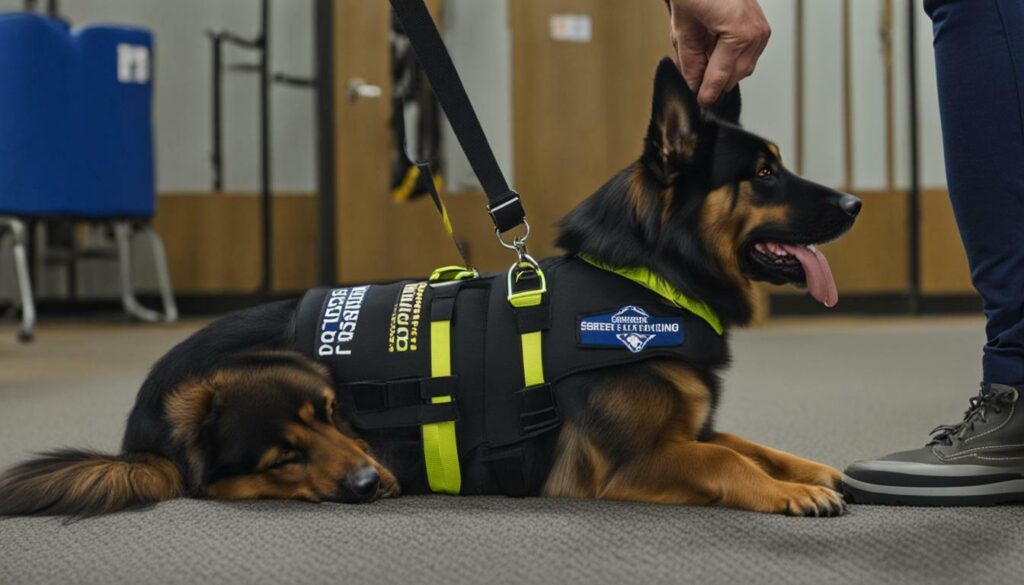
While preparing for the Public Access Test, remember to remain patient and consistent with your training. Each dog learns at its own pace, and it may take some time for your service dog to master all the necessary skills. Practicing frequently in various public settings and gradually increasing the difficulty level can help your dog become more adaptable and confident.
Health and Wellness for Service Dogs
Maintaining the health and wellness of your service dog is crucial for their overall well-being and performance. Adequate nutrition, exercise, grooming, and veterinary care are essential to keeping your service dog in optimal condition throughout their training and service. Here are some tips on how to keep your service dog healthy and happy!
Nutrition
Proper nutrition is essential for your service dog’s health and performance. Choose high-quality dog food that is appropriate for your dog’s age, size, and activity level. Feeding your dog a balanced diet that includes protein, carbohydrates, fats, vitamins, and minerals will help maintain their energy and stamina.
Consult your veterinarian to determine the appropriate feeding schedule and portion size for your service dog. Avoid overfeeding, which can lead to obesity and other health problems.
Exercise
Regular exercise is necessary to keep your service dog physically and mentally fit. Depending on your dog’s breed and age, they may require daily walks, runs, or other forms of exercise. Aim for at least 30 minutes of moderate to high-intensity exercise per day.
Incorporating training exercises into your dog’s routine can also provide mental stimulation and improve their skills. However, avoid overexertion and excessive exercise, which can cause injury or exhaustion.
Grooming
Regular grooming is essential to keep your service dog clean, comfortable, and healthy. Brushing your dog’s coat regularly can prevent matting, remove loose hair, and distribute natural oils for a shiny and healthy coat.
Trimming your dog’s nails and cleaning their ears can also prevent infections and discomfort. Regular dental care, including teeth brushing and professional cleaning, can prevent dental problems and bad breath.
Veterinary Care
Regular veterinary check-ups and preventive care are crucial for your service dog’s health. Schedule annual visits with your veterinarian for vaccinations, physical exams, and parasite prevention.
Be alert for any signs of illness or injury in your service dog and seek immediate veterinary care if necessary. Early detection and treatment can prevent serious health problems and ensure your service dog remains in optimal condition for their important work.
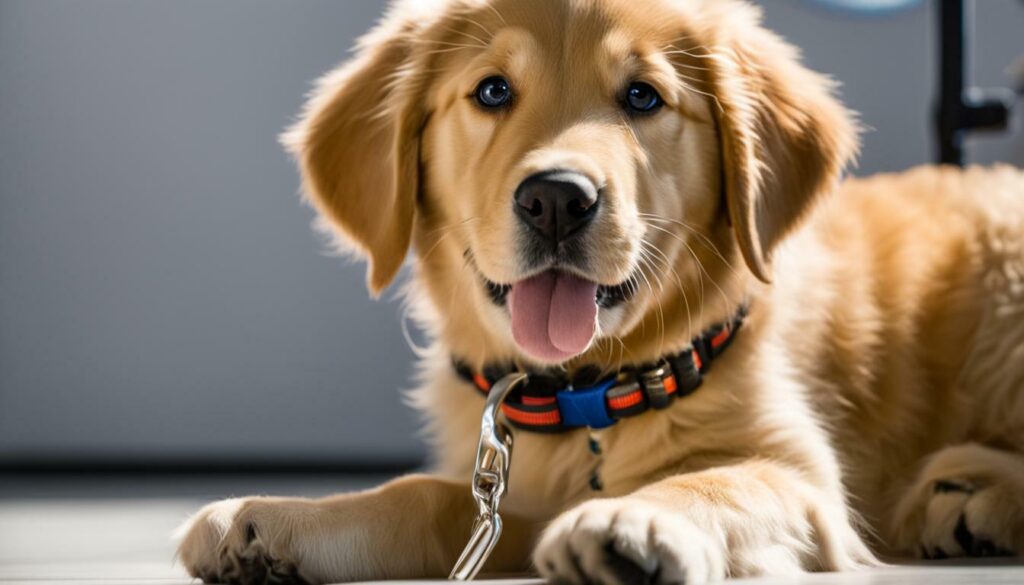
Training a service dog goes beyond just teaching them tasks and commands. It’s essential to develop a strong bond and trust with your dog to create a positive working relationship. Here are some best practices for building a strong bond with your service dog:
- Establish regular playtime and bonding activities such as walks or grooming sessions
- Use positive reinforcement to encourage good behavior and obedience
- Develop clear communication through consistent commands and gestures
- Practice patience and understanding during training sessions, avoiding punishment or aggression
Remember, a service dog is a highly trained companion who provides critical assistance to individuals with disabilities. Building a strong bond and trust is critical to ensure both the dog and handler can work together effectively.
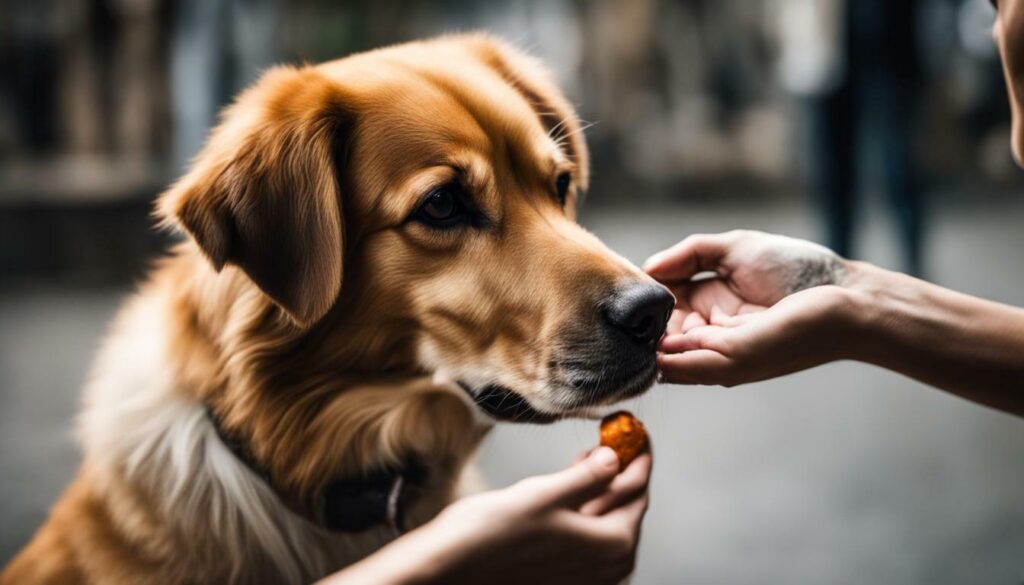
Service dog training is an ongoing process that requires dedication and consistency. Even after your dog has completed the initial training phase, it’s crucial to continue reinforcing their learned behaviors and introducing new skills to ensure they remain in top form. Professional service dog training programs can provide ongoing guidance and support throughout your dog’s service career.
Consistency is key when it comes to maintaining your dog’s training. Schedule regular training sessions to keep your dog’s skills sharp and prevent regression. It’s also essential to integrate your dog’s training into their daily routine, as this will reinforce good habits and make their behaviors more reliable.
When continuing your dog’s training, it’s important to gradually increase the difficulty of the tasks. Start with easier tasks and gradually progress to more challenging ones. This will help your dog build their skills and confidence over time.
In addition to maintaining your dog’s physical abilities, it’s also crucial to prioritize their mental and emotional well-being. Provide plenty of exercise and playtime, and ensure that they receive proper nutrition and veterinary care. A happy and healthy dog will be more motivated and eager to learn.
Professional service dog training programs can be a valuable resource for continuing your dog’s training. These programs can offer advanced training in specialized tasks, as well as ongoing support and guidance. They can also help you navigate any challenges that may arise during your dog’s service career.
Remember, service dog training is an ongoing journey, and it requires patience, dedication, and a commitment to providing your dog with the tools and skills necessary to be a successful service dog.
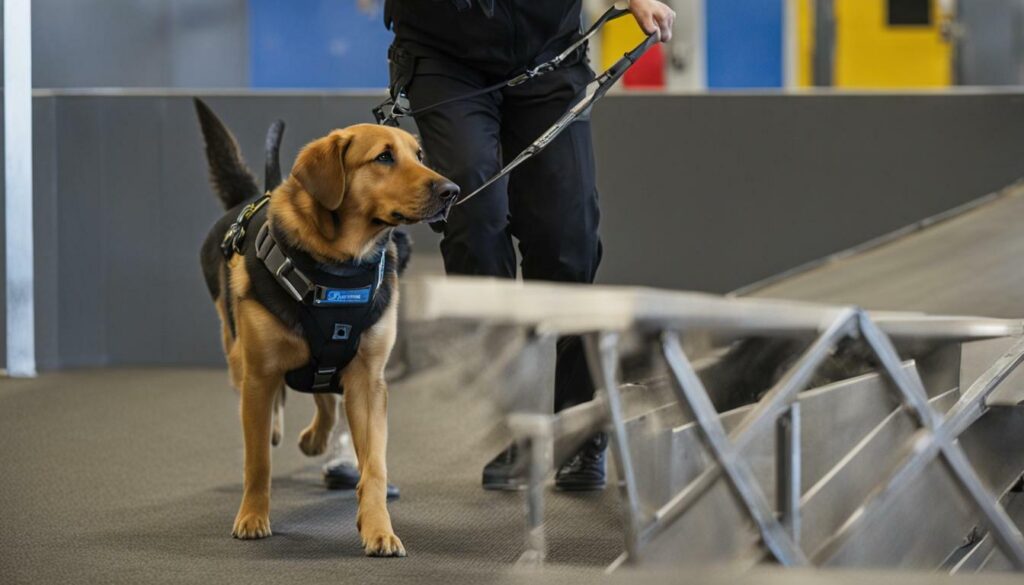
Service dog training can encounter various challenges along the way. However, with patience, persistence, and the right techniques, you can overcome them and ensure steady progress in your dog’s training journey. Here are some common service dog training challenges and how to troubleshoot them:
Behavioral Problems
Service dogs can develop behavioral problems such as fearfulness, aggression, or anxiety, which can hinder their training progress or put their handlers at risk. If you notice any concerning behavior, seek professional help from a certified dog trainer or a behaviorist. They can assess your dog’s behavior and design a customized training plan that addresses the underlying causes of the behavior and teaches your dog new, positive behaviors.
Distractions
Service dogs encounter numerous distractions in real-life situations which can challenge their focus and training progress. To prepare your dog for such distractions, gradually introduce them to different environments, people, and stimuli outside their training space. Start with less distracting environments and gradually increase the level of distractions, always ensuring that your dog is comfortable and not overwhelmed. Teach your dog to remain focused on you despite the distractions, and reward them for their progress.
Regression in Training
It’s common for service dogs to experience regression in their training progress, such as forgetting commands or displaying previously learned negative behaviors. This can be frustrating but is a normal part of the training process. If this happens, ensure that you are using consistent training techniques and review the commands with your dog in a positive and supportive way. Go back to the basics and reinforce the previous commands before moving on to new ones.
By troubleshooting these common challenges, you can maintain steady progress in your dog’s training journey, and ensure that they are well-equipped to assist individuals with disabilities.
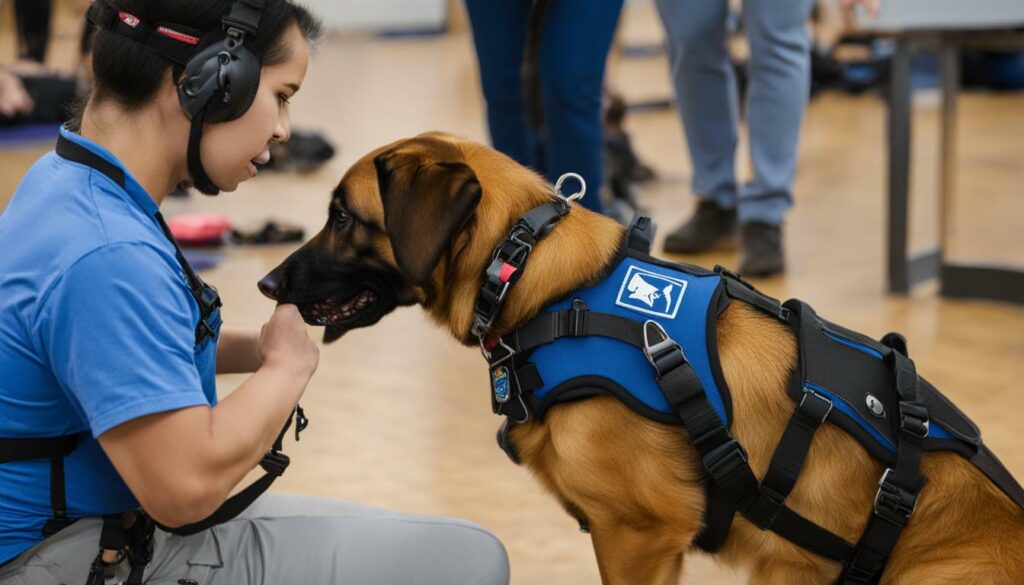
After months of hard work and dedication, your dog is now ready to become a service dog. However, there are still some steps you need to take to finalize the training process.
Evaluation and Assessment Procedures
Before your dog can be recognized as a service dog, they need to undergo a thorough evaluation and assessment. This will ensure that your dog meets the necessary standards for temperament, behavior, and skills required to perform their duties as a service dog.
The evaluation includes testing your dog’s obedience, alertness, and ability to perform specific tasks. It is important to schedule the evaluation with a reputable organization that specializes in service dog training and certification.
Service Dog Training Certification
Service dog training certification is an important requirement for your dog to be recognized as a service dog. Certification ensures that your dog has undergone the necessary training and meets the criteria necessary to perform their duties as a service dog.
There are various organizations that offer service dog certification, so it is essential to research and choose a reputable organization. The certification process typically includes verification of the dog’s skills, obedience, and temperament.
Legal Considerations
Service dogs are protected under the Americans with Disabilities Act (ADA) and have certain legal rights. It is important to be aware of these rights and ensure that your dog is recognized as a service dog under the law.
Registration of your service dog with the National Service Animal Registry is optional; however, it can provide additional legal protection. Ensure to consult with legal professionals for more information.
As you finalize the service dog training process, remember the immense impact that your dog will have on someone’s life. Their dedication and hard work will provide a sense of independence and freedom to those in need. By taking the time to complete the necessary steps, you can help your dog fulfill their rewarding role as a service dog.
FAQ
Q: What is this section about?
A: This section provides a comprehensive guide on training your dog to become a service dog.
Q: What will I learn in this section?
A: You will learn efficient steps and helpful tips to equip your canine companion with the skills necessary to assist individuals with disabilities.
Q: What is the role of a service dog?
A: Before embarking on the training process, it’s crucial to understand the role of a service dog. Learn about the legal requirements, responsibilities, and the key qualities necessary for a successful service dog.
Q: How do I select the right dog for service work?
A: Choosing the right dog for service work is essential to ensure their suitability for the role. Discover the factors to consider when selecting a dog for training and the specific requirements for service dog candidates.
Q: How do I establish basic obedience training?
A: Before diving into specialized tasks, it’s crucial to establish a solid foundation of basic obedience training. Explore professional service dog training programs that can help you teach your dog essential commands such as sit, stay, come, and heel.
Q: How do I introduce public etiquette and socialization?
A: Public etiquette and socialization are vital aspects of service dog training. Discover the tips and techniques to expose your dog to various environments, people, and distractions in a controlled manner.
Q: What tasks should I train my service dog for?
A: Different disabilities require different tasks from service dogs. Dive into the specific techniques and strategies to train your dog for tasks relevant to the disability they will be assisting with.
Q: How do I handle distractions and challenges?
A: Service dogs encounter numerous distractions and challenges in their work. Learn effective methods to train your dog to remain focused and calm in various situations.
Q: How do I prepare for a public access test?
A: To ensure the safety and reliability of service dogs, they must pass a public access test. Understand the requirements and criteria for the test and learn how to prepare your dog for success.
Q: How do I maintain the health and wellness of my service dog?
A: Maintaining the health and wellness of service dogs is crucial for their overall well-being and performance. Discover tips and guidelines for proper nutrition, exercise, grooming, and veterinary care.
Q: How do I build a strong bond and trust with my service dog?
A: Developing a strong bond and trust between you and your service dog is essential for effective training and teamwork. Learn techniques to strengthen the bond, reinforce positive behaviors, and establish clear communication with your dog.
Q: How do I continue training after the initial phase?
A: Service dog training is an ongoing process even after the initial training phase. Understand the importance of maintaining and continuing training to reinforce learned behaviors and introduce new skills.
Q: What should I do in case of common challenges?
A: Service dog training can encounter various challenges along the way. Learn how to troubleshoot common issues such as behavioral problems, distractions, or regression in training.
Q: How do I finalize the service dog training process?
A: In this final section, we will explore the steps to finalize the service dog training process. Learn about the evaluation and assessment procedures, certification requirements, and legal considerations for your dog to officially become a recognized service dog.
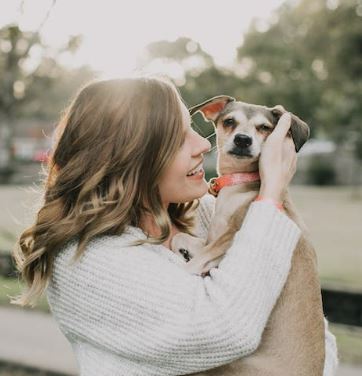
Marissa Delotta, 36, from Dayton, Ohio, is the creative force behind Roverboard.com, a beloved online destination for dog lovers. As a dedicated mom and canine enthusiast, Marissa combines her family experiences with her love for dogs to offer a platform where dog owners can exchange tips, heartwarming stories, and advice. Her website has become a vibrant community for sharing the joys of dog parenting. In her free time, Marissa enjoys exploring dog parks with her family and volunteering at local animal shelters.